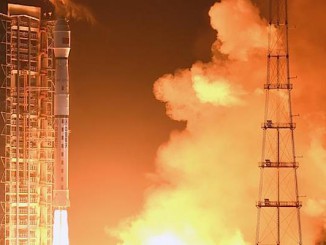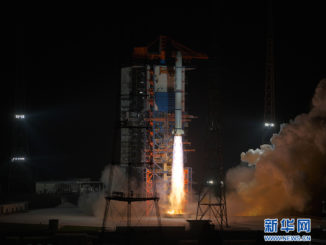
The Chinese Chang’e 5 mission accomplished the first robotic docking between two spacecraft orbiting the moon Saturday, when a lunar ascent spacecraft linked up with an Earth return vehicle and transferred a container of moon rocks to bring home in mid-December.
The two solar-powered spacecraft docked in lunar orbit at 4:42 p.m. EST (2142 GMT) Saturday, according to the China National Space Administration, completing an automated rendezvous sequence that demonstrated deep space guidance and navigation technology.
A claw on the Chang’e 5 orbiter captured the ascender to complete the link-up in lunar orbit.
The container of moon rocks collected on the lunar surface was transferred from the ascent vehicle to the Earth return spacecraft at 5:12 p.m. EST (2212 GMT), Chinese officials said.
After confirming the sample transfer, the Chang’e 5 return craft jettisoned the ascent vehicle at 11:35 p.m. EST Saturday (0435 GMT Sunday). The ascender will be left behind in lunar orbit when the return ship comes back to Earth in mid-December.
The return vehicle is expected to fire its engines to leave the moon’s orbit Dec. 13, setting course for landing of the sample capsule in China’s Inner Mongolia region a few days later.
In this video from China’s space agency, the Chang’e 5 sample return mission ascent vehicle — with a crescent Earth behind it — approaches a return craft in orbit around the moon.
Chang’e 5 completed the first robotic docking in lunar orbit Saturday.https://t.co/kS5te7aytd pic.twitter.com/h8OPd0VCo9
— Spaceflight Now (@SpaceflightNow) December 6, 2020
The docking Saturday occurred two days after the Chang’e 5 ascent vehicle launched from the moon’s surface, the first takeoff of a spacecraft from a large planetary body since the Soviet Union’s Luna 24 mission in 1976. Luna 24 was also the last mission to return lunar materials to Earth.
The automatic docking between the Chang’e 5 ascender and return vehicle was similar to maneuvers performed by NASA’s Apollo missions. On those flights, astronauts docked the Apollo lunar and command modules in orbit around the moon.
Experts considered the launch of the Chang’e 5 ascent vehicle and the automated docking in lunar orbit two of the sample return mission’s most challenging phases.
After Chang’e 5 returns to Earth later this month, scientists will take the lunar material to a climate-controlled facility to begin analyses on the rocks. Researchers hope to learn about the moon’s history and evolution.
After docking in lunar orbit, the Chang’e 5 sample carrier containing moon rocks was transferred from the mission’s ascent craft into the vehicle that will return the samples to Earth. https://t.co/kS5te7aytd pic.twitter.com/UaJZulorDR
— Spaceflight Now (@SpaceflightNow) December 6, 2020
Chang’e 5 launched Nov. 23 and entered orbit around the moon Nov. 28 before the lander detached from the mission’s orbiter and return module to begin descent maneuvers.
The successful landing of Chang’e 5 on Tuesday marked the third time China has soft-landed a spacecraft on the moon, following the Chang’e 3 mission in 2013 and Chang’e 4 in 2019. Chang’e 4 became the first spacecraft to achieve a soft landing on the far side of the moon, a feat enabled by the placement of a purpose-built Chinese data relay satellite in deep space.
Chang’e 3 and Chang’e 4 carried rovers to serve as mobile scouts exploring the lunar landscape. Chang’e 5’s mission on the lunar surface had no mobile rover, and the craft was designed to complete its work in two days while in sunlight, rather than surviving the two-week super-cold lunar night.

Chinese officials said the Chang’e 5 surface mission proceeded as planned. CNSA confirmed the lander first drilled samples from a depth of up to 6.6 feet, or 2 meters, then used a scoop at the end of a robotic arm to gather soil from the surface.
The spacecraft packaged and sealed the lunar material in a storage device carried by the Chang’e 5 ascender before it took off Thursday.
The Chang’e 5 mission’s goal was to collect more than 4 pounds, or 2 kilograms, of rocks for return to Earth. Chinese officials have not released an estimate of how much material the spacecraft gathered on the moon.
The Chang’e lunar program is named for a moon goddess in Chinese folklore.
Email the author.
Follow Stephen Clark on Twitter: @StephenClark1.



